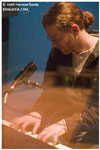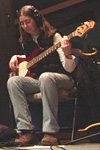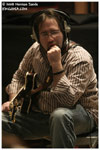On Models and
Metrics
~Jordan
Wilkow, September '08
 It
seems to me that I spend a disproportionate amount of time thinking about things
like, "how do I get where I'm trying to go in life," "why am
I trying to get there," "should I be trying to get there," and
"where might I be trying to go instead." And I've got to say, it's
exhausting. I suppose it comes from trying to lead what they call an "examined
life," and while I know the opposite is not supposed to be worth living,
it sure can be a grind sometimes. And so, what is the right example to follow?
Professionally, personally…which musician's/father's/executive's/friend's
framework reveals the guide? And how do we measure our progress along the way?
By what scale do we evaluate our successes and failures? What is the model,
and what is the metric?
It
seems to me that I spend a disproportionate amount of time thinking about things
like, "how do I get where I'm trying to go in life," "why am
I trying to get there," "should I be trying to get there," and
"where might I be trying to go instead." And I've got to say, it's
exhausting. I suppose it comes from trying to lead what they call an "examined
life," and while I know the opposite is not supposed to be worth living,
it sure can be a grind sometimes. And so, what is the right example to follow?
Professionally, personally…which musician's/father's/executive's/friend's
framework reveals the guide? And how do we measure our progress along the way?
By what scale do we evaluate our successes and failures? What is the model,
and what is the metric?
These are the
questions that in ways large and small helped to bring about the songs on our
new album. In "Every Time You Shake It" we work up the courage to
declare an answer. In "The Unlimited Space Around Us" we marvel at
the enormity of the question, and reach for those things that might reveal a
clue. "We Could" follows where one potential model might lead, and
"Professionals Here" another, "White Picket Fence" still
another. "Another Before I Go" is a bit of a cathartic venting of
frustrations and aggravations - those moments when we are most overwhelmed and
fed up. "Falling off the Fence" seeks the comfort to be found in finally
putting a decision to rest and choosing a course of action. "Well in Hand"
attempts to earnestly take stock. To appreciate fully what we know, and to embrace
the journey to discover what we don't, to recall with fondness and appreciation
where we've been, and to reaffirm our readiness to greet whatever may lie ahead.
We're taking a
close look, and trying earnestly and honestly to get it right.
Studio vs.
Live
~Janis Wallin, September '08
 Most
of the tunes on Models and Metrics had been in regular live rotation
for a solid period of time. While I generally think FGC shines a little more
in a live setting than the studio, I was really pleased (and in some cases very
pleasantly surprised) as to how the studio versions of these tunes turned out.
Below is a glimpse of how we approached and changed certain songs for the album.
Most
of the tunes on Models and Metrics had been in regular live rotation
for a solid period of time. While I generally think FGC shines a little more
in a live setting than the studio, I was really pleased (and in some cases very
pleasantly surprised) as to how the studio versions of these tunes turned out.
Below is a glimpse of how we approached and changed certain songs for the album.
Vocals
We experimented with some additional background vocals for this album. I added
some vocal harmonies to the choruses of "Every Time You Shake It"
and "Falling Off the Fence" that I think give a lot of warmth and
rich dimension to the tunes. On "White Picket Fence," we added a few
additional layers as well. We also incorporated some vocal effects toa couple
songs, the highlights of which are the interesting tone of Jordan's vocals on
"Another Before I Go" and the classic evil laugh on "Tutear."
We all consider Jordan a genius for coming up with the latter!
Arrangements
A lot of the songs retained their basic live arrangements, but we retooled a
few for the studio. "We Could" is probably the most drastic. We cut
out the long solo section in the middle, leaving the bridge as just a short
melodic statement. It was a bit hard to get used to at first, since the solo
section has such a powerful effect live, but I think the end result makes for
a concise studio composition. We also changed the ending of "The Unlimited
Space Around Us" to a fade-out, as opposed to its normal live ending of
returning to the main groove and ending tightly. I think this adds a nice sailing
element to the song. For "White Picket Fence," the original intention
was to fade it out, but we ending up liking the impromptu ending that happened
while tracking the take, so we kept it!
Solos
A lot of the solos on this album stayed true to their live counterparts. The
guitar solos on "Every Time You Shake It" and "The World Is Watching
(part two)", and the keyboard solos on "White Picket Fence" and
"Professionals Here" all borrowed a lot of structure and melody from
what usually happens live. However, a few solos took a new turn when we recorded
the album, notably, the guitar solos on "Falling Off the Fence" and
"Well In Hand." Adam tried some interesting chord melody for "Falling,"
and more key-center based melodic ideas for the first half of the "Well
In Hand" solo. I thought both turned out really nice.
Recording
Process and History
-Adam Lewis, September '08
 When
we recorded our first album, Reachin', we were overwhelmingly in favor
of keeping the recording true to our live performance and didn't want to track
anything that we couldn't replicate live. When we released the album there were
no layers, recording tricks, or fancy engineering footwork that adulterated
our sound. What you saw was what you got, which is something we truly believed
was the right choice for us at that moment and I fondly look back on the record
for that reason and more.
When
we recorded our first album, Reachin', we were overwhelmingly in favor
of keeping the recording true to our live performance and didn't want to track
anything that we couldn't replicate live. When we released the album there were
no layers, recording tricks, or fancy engineering footwork that adulterated
our sound. What you saw was what you got, which is something we truly believed
was the right choice for us at that moment and I fondly look back on the record
for that reason and more.
I was convinced
at the time of that recording that we should record to tape rather than into
ProTools (see below * for an explanation of tape and ProTools). The idea of
digital recording was not something that appealed to me and most of the albums
that I had grown to love were analog recordings. We tracked to tape, transferred
the best takes to ProTools, then over-dubbed guitars, keys and vocals in ProTools,
mixed back down to ½" tape and ultimately mastered back to digital.
It was a long and not particularly cost effective process but I was genuinely
pleased with the sound of the album when it was completed.
It had been four years between recording Reachin' and our second CD,
The Charmer. FGC had become ambitious in our songwriting and subsequently
ambitious in our search for a more refined sound. After scouring Chicago's studios
and engineers we found Studio Chicago, a classy, well maintained studio, and
Chuck Kawal, a veteran engineer who had a knack for recording clean professional
sounding material. The band was still interested in keeping the recording as
true to the live experience as possible but were beginning to open up to alternative
tones and effects that were atypical of FGC. Though given the lapse in time
between our first effort and this one, we were weary of being too experimental.
On a personal level, we felt that there was a lot on the line with this record
and that we were trying to show the "world" that we were professionals.
We wanted a neat, clean, pro record, which is what we got.
Chuck who was
much more comfortable working in the digital realm convinced me that the differences
between recording via a digital medium versus analog were negligible, so despite
my better judgment, we took a spin on the digital highway. While I am proud
of The Charmer, my only regret is that it sounds too pristine and possibly
a bit sterile, which in some part I believe is due to choosing to record digitally.
There's no question that we went into the recording process chasing after a
clean sound but somehow we sacrificed density and fullness in that pursuit.
In the long run, I'm glad we did what we did and I am a wiser man for it. The
process of recording The Charmer taught me a good deal about how I wanted
to record our next album.
Models & Metrics is our fourth record (following our successful live
album, Live in Chicago, also engineered by Chuck Kawal) and by far the
one I am most proud of to date. With our debut and sophomore works under our
belt we felt the chains loosen up a bit. We collectively arrived at the conclusion
that a studio album did not necessarily have to represent what the band was
doing live. That in fact it was a different animal with different rules (which
funny enough, is the exact same way I think about Janis *wink*). That there
is no foul in expressing one's artistry this way as long as it's honest. This
record was about taking risks. We edited together things that we could never
do live (Falling of the Fence intro), we layered multiple guitars to create
a much bigger sound than we had ever done before (The Unlimited Space Around
Us, We Could, Tutear, World is Watching, Another Before I Go), we played with
vocal tones and used Beatles-style effects to add to the flavor of Jordan's
musings (TUSAU, ABIG), crunched up the Rhodes and bass when necessary to maximize
our rocking out potential (WiW, ABIG), etc. Consequently this album is a great
deal of fun. It's just as serious and thoughtful as our previous recordings
but has a playfulness that is really engaging.
We went back to
analog recording to the dismay of old Chuckie with this session, but I couldn't
be happier with the results and it's going to take an enormous amount to convince
me not to continue to record this way. We tracked all the drums, bass, keys
and half the guitars at Studio Chicago over three days and we overdubbed the
rest of the guitars, vocals and percussion at our home studios over the next
couple of months. I personally love tracking guitars at home because I'm a tone
nut. It gives me all the time in the world to get extraordinary sounds and play
with ideas without having to worry that the studio clock is ticking and costing
us money.
It is evident
from Models & Metrics that we've grown as musicians as well as producers.
We've learned from our mistakes and have learned from chances that we've taken.
This album is a really nice collection of ideas from four people who have spent
the last seven years building on and learning from one another in all walks
of life. It is a reflection of our commitment to the music and to our vision
for the future.
Get our record,
you'll like it.
* Tracking to tape is the antiquated analog system of recording, which is slow
and not particularly versatile, but in my opinion yields a particularly desirable
tone. ProTools is the industry standard in digital recording software. Analog
recording essentially takes a continuous stream of audio and puts it to a tape
(not unlike the tape that's in all those cassettes that we used to trade shows
on, just much larger and thicker). The audio becomes slightly compressed when
it hits tape and gives the recording a slightly fuller sound. Digital recording
takes thousands of "snapshots" a second of the audio and plays them
back similar to how a flipbook works. Digital recording is thought by some to
be a more truthful representation of the performance due to the fact that tape
compression is out of the equation, but many purists, like myself, believe that
compression is more desirable.
 It
seems to me that I spend a disproportionate amount of time thinking about things
like, "how do I get where I'm trying to go in life," "why am
I trying to get there," "should I be trying to get there," and
"where might I be trying to go instead." And I've got to say, it's
exhausting. I suppose it comes from trying to lead what they call an "examined
life," and while I know the opposite is not supposed to be worth living,
it sure can be a grind sometimes. And so, what is the right example to follow?
Professionally, personally…which musician's/father's/executive's/friend's
framework reveals the guide? And how do we measure our progress along the way?
By what scale do we evaluate our successes and failures? What is the model,
and what is the metric?
It
seems to me that I spend a disproportionate amount of time thinking about things
like, "how do I get where I'm trying to go in life," "why am
I trying to get there," "should I be trying to get there," and
"where might I be trying to go instead." And I've got to say, it's
exhausting. I suppose it comes from trying to lead what they call an "examined
life," and while I know the opposite is not supposed to be worth living,
it sure can be a grind sometimes. And so, what is the right example to follow?
Professionally, personally…which musician's/father's/executive's/friend's
framework reveals the guide? And how do we measure our progress along the way?
By what scale do we evaluate our successes and failures? What is the model,
and what is the metric? Most
of the tunes on Models and Metrics had been in regular live rotation
for a solid period of time. While I generally think FGC shines a little more
in a live setting than the studio, I was really pleased (and in some cases very
pleasantly surprised) as to how the studio versions of these tunes turned out.
Below is a glimpse of how we approached and changed certain songs for the album.
Most
of the tunes on Models and Metrics had been in regular live rotation
for a solid period of time. While I generally think FGC shines a little more
in a live setting than the studio, I was really pleased (and in some cases very
pleasantly surprised) as to how the studio versions of these tunes turned out.
Below is a glimpse of how we approached and changed certain songs for the album. When
we recorded our first album, Reachin', we were overwhelmingly in favor
of keeping the recording true to our live performance and didn't want to track
anything that we couldn't replicate live. When we released the album there were
no layers, recording tricks, or fancy engineering footwork that adulterated
our sound. What you saw was what you got, which is something we truly believed
was the right choice for us at that moment and I fondly look back on the record
for that reason and more.
When
we recorded our first album, Reachin', we were overwhelmingly in favor
of keeping the recording true to our live performance and didn't want to track
anything that we couldn't replicate live. When we released the album there were
no layers, recording tricks, or fancy engineering footwork that adulterated
our sound. What you saw was what you got, which is something we truly believed
was the right choice for us at that moment and I fondly look back on the record
for that reason and more.